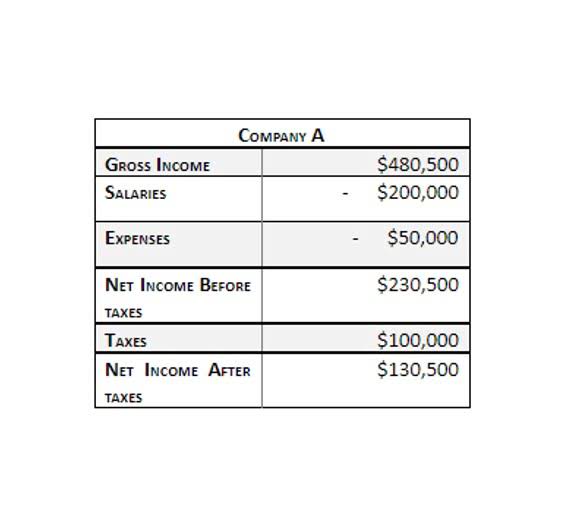
In other words, using the POHR formula gives a clearer picture of the profitability of a predetermined overhead rate business and allows businesses to make more informed decisions when pricing their products or services. In this article, we will discuss the formula for predetermined overhead rate and how to calculate it. The allocation of overhead to the cost of the product is also recognized in a systematic and rational manner. The overhead is then applied to the cost of the product from the manufacturing overhead account. The overhead used in the allocation is an estimate due to the timing considerations already discussed. For example, the recipe for shea butter has easily identifiable quantities of shea nuts and other ingredients.

Applications of Predetermined Overhead Rates
Further, it is stated that the reason for the how is sales tax calculated same is that overhead is based on estimations and not the actuals. Suppose that X limited produces a product X and uses labor hours to assign the manufacturing overhead cost. The estimated manufacturing overhead was $155,000, and the estimated labor hours involved were 1,200 hours. Overhead costs are then allocated to production according to the use of that activity, such as the number of machine setups needed. In contrast, the traditional allocation method commonly uses cost drivers, such as direct labor or machine hours, as the single activity. Moreover, predetermined overhead cost rates enhance budgetary control and financial planning by providing a clear framework for managing overhead expenses.
- A large organization uses multiple predetermined overhead recovery rates to allocate its expenses to the cost centers.
- It would involve calculating a known cost (like Labor cost) and then applying an overhead rate (which was predetermined) to this to project an unknown cost (which is the overhead amount).
- This project is going to be lucrative for both companies but after going over the terms and conditions of the bidding, it is stated that the bid would be based on the overhead rate.
- Estimating overhead costs is difficult because many costs fluctuate significantly from when the overhead allocation rate is established to when its actual application occurs during the production process.
- For businesses in manufacturing, establishing and monitoring an overhead rate can help keep expenses proportional to production volumes and sales.
Limitations of Predetermined Overhead Rates
Based on the manufacturing process, it is also easy to determine the direct labor cost. But determining the exact overhead costs is not easy, as the cost of electricity needed to dry, crush, and roast the nuts changes depending on the moisture content of the nuts upon arrival. Different methods are used to apply predetermined overhead rates based on the chosen cost driver. The example shown above is known as the single predetermined overhead rate or plant-wide overhead rate. Different businesses have different ways of costing; some would use the single rate, others the multiple rates, while the rest may make use of activity-based costing.
Formula to Calculate Predetermined Overhead Rate

The comparison of applied and actual overhead gives us the amount of over or under-applied overhead during the period which is eliminated through recording appropriate journal entries at the end of the period. Calculating predetermined overhead rates involves estimating total overhead costs and selecting an appropriate allocation base. In summary, predetermined overhead cost rates are a valuable tool in cost accounting that ensures accurate and timely allocation of overhead costs, enhances budgetary control, and supports effective financial planning. The formula for a predetermined overhead rate is expressed as a ratio of the estimated amount of manufacturing overhead to be incurred in a period to the estimated activity base for the period. The predetermined overhead rate formula can be used to balance expenses with production costs and sales. For businesses in manufacturing, establishing and monitoring an overhead rate can help keep expenses proportional to production volumes and sales.

Whereas, the activity base used for the predetermined overhead rate calculation is usually machine hours, direct labor hours, or direct labor costs. Albert Shoes Company calculates its predetermined overhead rate on the basis of annual direct labor hours. At the Accounts Payable Management beginning of year 2021, the company estimated that its total manufacturing overhead cost would be $268,000 and the total direct labor cost would be 40,000 hours.
The Role of Predetermined Overhead Rates in Cost Accounting
Manufacturing overhead costs include all manufacturing costs except for direct materials and direct labor. Estimating overhead costs is difficult because many costs fluctuate significantly from when the overhead allocation rate is established to when its actual application occurs during the production process. You can envision the potential problems in creating an overhead allocation rate within these circumstances. The estimated or budgeted overhead is the amount of overhead determined during the budgeting process and consists of manufacturing costs but, as you have learned, excludes direct materials and direct labor. Examples of manufacturing overhead costs include indirect materials, indirect labor, manufacturing utilities, and manufacturing equipment depreciation. Another way to view it is overhead costs are those production costs that are not categorized as direct materials or direct labor.

B. Cost Accounting Software
- The fact is production has not taken place and is completely based on previous accounting records or forecasts.
- The actual total manufacturing overhead incurred for the year was $247,800 and actual direct labor hours worked during the year were 42,000.
- Since the numerator and denominator of the POHR formula are comprised of estimates, there is a possibility that the result will not be close to the actual overhead rate.
- Management analyzes the costs and selects the activity as the estimated activity base because it drives the overhead costs of the unit.
- Create a Full Dynamic Financial Model in 2 Days (6 hours)
They enable businesses to compare actual overhead costs with the estimated rates, identify variances, and take corrective actions if necessary. This proactive approach to overhead cost management supports better decision-making and resource allocation, ultimately contributing to the overall financial health and efficiency of the business. This method helps in maintaining accurate and up-to-date cost information, which is essential for setting product prices, controlling costs, and analyzing profitability. A predetermined overhead rate is an allocation rate that is used to apply the estimated cost of manufacturing overhead to cost objects for a specific reporting period. This rate is frequently used to assist in closing the books more quickly, since it avoids the compilation of actual manufacturing overhead costs as part of the period-end closing process.
For instance, if the activity base is machine hours, you calculate predetermined overhead rate by dividing the overhead costs by the estimated number of machine hours. This is calculated at the start of the accounting period and applied to production to facilitate determining a standard cost for a product. The predetermined overhead rate is set at the beginning of the year and is calculated as the estimated (budgeted) overhead costs for the year divided by the estimated (budgeted) level of activity for the year. This activity base is often direct labor hours, direct labor costs, or machine hours. Once a company determines the overhead rate, it determines the overhead rate per unit and adds the overhead per unit cost to the direct material and direct labor costs for the product to find the total cost.
